A small update; 5/21/2015
Here's the trio colony with a cricket leg that they pulled over to their brood. Clearest picture yet, was taken with a iPhone 6. ![]()
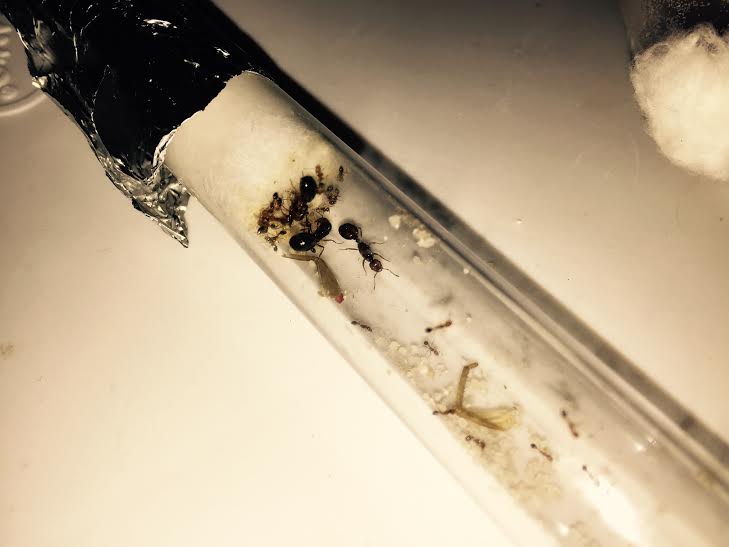

A small update; 5/21/2015
Here's the trio colony with a cricket leg that they pulled over to their brood. Clearest picture yet, was taken with a iPhone 6. ![]()

Update; 6/22/2015.
So bad news everyone. When I came back from my fathers, one queen was dead in the trio colony with 8 workers piled with her. Another queen (now dead) was damaged, missing her tibia in the left front pair of legs as well as the back leg was fully torn off. The other queen was healthy looking and looked fine but the heat mat was very hot so I took them off it and offered two cricket legs. They didn't eat the cricket legs so I just observed them for a little while before deciding to move them to a clean new test tube. The move went perfectly and I went to bed. I checked on them today and they where alive, now a few hours later the damage queen was dead. I offered them a cricket leg and they rejected it but took the sugar water I gave them.
After putting them under the heat mat again (I put lays of paper under) and after 5 minutes two more workers died. I took them out again and the test tube wasn't even hot, more of a coldish-warm. The brachymyrmex queen on the right didn't seem effected at all by the heat as well so the only answer was the queens had a battle with the others and workers and left 8 dead, 1 queen dead and another injured that eventually those workers let die. Though it's kinda obscure on he events that happened since I didn't witness the deaths occur and how inconsistent it was with the temperature. They piled the brood on the cotton for some reason though but now they're on the floor of the test tube. I don't know what's going on and I doubt it's toxicity or disease-related since the workers/queens displayed no unusual behaviors.
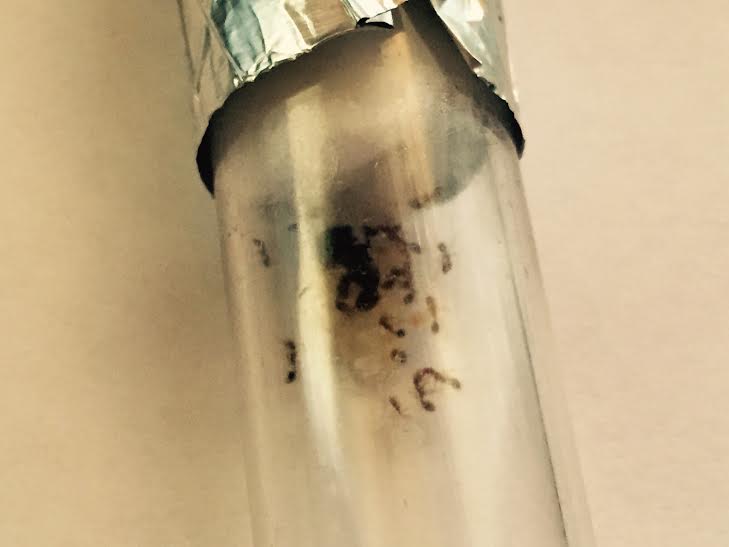
This is them as of now after I cleaned the tube and thrown out the body of the queen and two workers that recently died
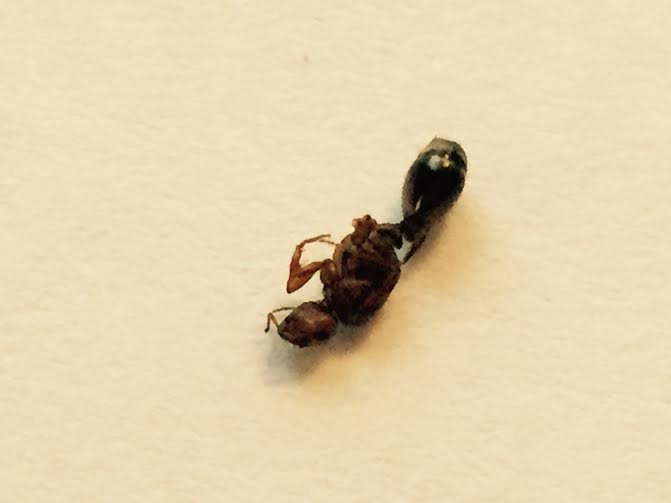
This is the queen that recently died today.
If anyone can determine what happened through my observations I would be most grateful.
Also since I took them off the heat mat no more deaths are occurring.
Edited by Bardusquus, June 22 2015 - 4:45 PM.
I know S.invicta and a lot of other ant species ( like Formica fusca) are only polygynous during the founding stages of the colony once the last worker encloses or the colony hits a certain population the workers will pick queens to kill until one is left. However the queens usually don't put up a fight so the deaths of the workers should be the heat mat.
In the wild stronger immature S.invicta colonies will "kidnap" brood from other weaker immature colonies , once all the brood and queens of the local population of RIFA are in one nest (usually the strongest nest) the workers will kill all the queens and only leave one surviving.
To expand upon that, there are a few strains of truly polygynous S. invicta that exist in Texas. However, as far as I know, they are NOT polygyne from nest founding. Instead the supernumerary queens are later adopted after nuptial flights. This is true for a very large majority of polygynous ants. There are very few polygynous ants that will have polygynous colony foundation without killing off all but one queen.
I know S.invicta and a lot of other ant species ( like Formica fusca) are only polygynous during the founding stages of the colony once the last worker encloses or the colony hits a certain population the workers will pick queens to kill until one is left. However the queens usually don't put up a fight so the deaths of the workers should be the heat mat.
In the wild stronger immature S.invicta colonies will "kidnap" brood from other weaker immature colonies , once all the brood and queens of the local population of RIFA are in one nest (usually the strongest nest) the workers will kill all the queens and only leave one surviving.
It was never the heat. Today the last queen of the trio colony has died with 4 more workers behind her. Leaving a total of 12 workers and a ton of brood. They weren't near any heat source and where blanketed outside so they don't cook.
I know S.invicta and a lot of other ant species ( like Formica fusca) are only polygynous during the founding stages of the colony once the last worker encloses or the colony hits a certain population the workers will pick queens to kill until one is left. However the queens usually don't put up a fight so the deaths of the workers should be the heat mat.
In the wild stronger immature S.invicta colonies will "kidnap" brood from other weaker immature colonies , once all the brood and queens of the local population of RIFA are in one nest (usually the strongest nest) the workers will kill all the queens and only leave one surviving.
It was never the heat. Today the last queen of the trio colony has died with 4 more workers behind her. Leaving a total of 12 workers and a ton of brood. They weren't near any heat source and where blanketed outside so they don't cook.
Oh. Interesting. Sometimes ants just die and you may never know why.
I know S.invicta and a lot of other ant species ( like Formica fusca) are only polygynous during the founding stages of the colony once the last worker encloses or the colony hits a certain population the workers will pick queens to kill until one is left. However the queens usually don't put up a fight so the deaths of the workers should be the heat mat.
In the wild stronger immature S.invicta colonies will "kidnap" brood from other weaker immature colonies , once all the brood and queens of the local population of RIFA are in one nest (usually the strongest nest) the workers will kill all the queens and only leave one surviving.
It was never the heat. Today the last queen of the trio colony has died with 4 more workers behind her. Leaving a total of 12 workers and a ton of brood. They weren't near any heat source and where blanketed outside so they don't cook.
Oh. Interesting. Sometimes ants just die and you may never know why.
The workers are still there and a ton of the brood just pupated.
Ok so the only abnormal behavior I see is that the queens repeatedly clean themselves after being introduced into the test tube but the workers do not. They brush their front legs onto their heads and sometimes run the front leg into the mouth as if cleaning. The last queen did this before dying or it could have purely been coincidental.
Edited by Bardusquus, June 23 2015 - 7:25 PM.
huh.
Not a update
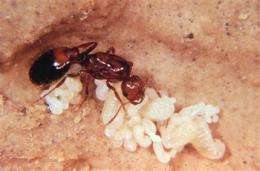
Well the trio colony in the test tube with now one queen that I took from the smaller substrate colony is doing great. Except when I took her out, she had a couple big larva that has grown to the size of the 3 large larva in the above photo. Is this alate larva? She had her own workers but then had these big larva despite haven't been fed before I introduced her into a new colony, and I'm afraid that she might have went sterile for some reason despite having workers from the first batch. Could it be because she didn't have enough reserves left or is she trying to raise a major? It's not big enough to be an alate larva- yet, but I'm worried and I can't take a picture right now as I have this crappy phone again.
Also ever since I introduced her she hasn't laid a new batch of eggs.
Edited by Bardusquus, June 25 2015 - 6:31 AM.
It is most likely a major.
There are many reasons why this can't be
1. The colony didn't have enough reserves to feed such a large larva
2. The colony was too small and new for such a big larva. It's smaller than the larva in the 4 queen colony which had tremendously big larva at pg.1
3. This larva was the first generation of workers, so I extremely doubt this would be a major considering how small the colony is anyway. About 2 weeks old now.
Unless solenopsis is known for having majors during the founding stages (I doubt since most people who have raised solenopsis had their first majors during when the colony went into the hundreds/thousands) then I think she went sterile for some reason, though it's unlikely. She hasn't been laying eggs which is making me more convinced that she went infertile out of nowhere. Could the large amount of daily cricket legs be causing this tremendous growth? Likely not as this larva was from the substrate container and they weren't being fed as the workers never ventured out to get food (also there was a small pile of brood with a couple pupa).
Edited by Bardusquus, June 25 2015 - 6:45 AM.
Interesting. Idunno. I heard someone fed a Pheidolegeton colony a lot of proteins and they produced alates a bit to early. Doubt it's the case here though.
I have as well. I think I remember even getting some nanitic Solenopsis "majors".Beautiful ants, and excellent pictures.
I've had Pheidole raise major nanitics.Do you have any colonies started from a solitary queen? I'm quite curious how long it takes (any polymorphous ant, not just Camponotus) for the first majors to appear.
Edited by Ants4fun, June 25 2015 - 9:04 AM.
A medium sized update
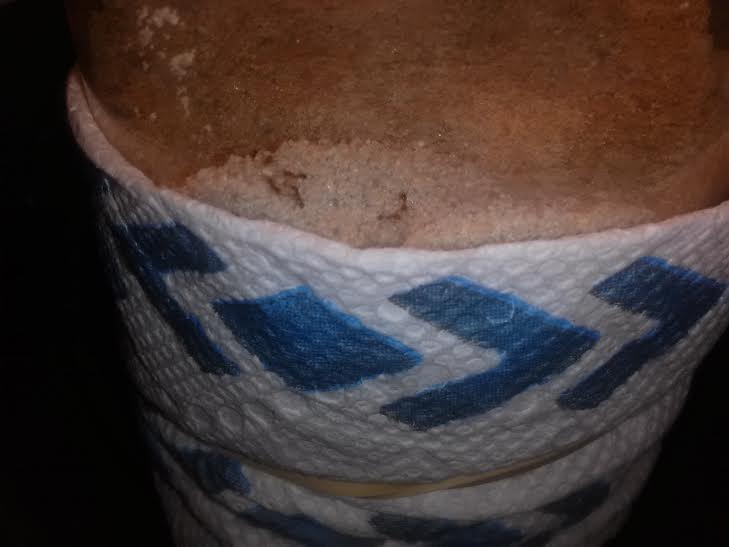
Le substrate enclosure colony digging thou crater-mound with a bunch of workers pouring out and placing pebbles everywhere.
Edited by Bardusquus, June 25 2015 - 11:13 AM.
What is keeping all that sand together? looks like a piece of cloth doing all of that.
What is keeping all that sand together? looks like a piece of cloth doing all of that.
It's a old vase for a plant that I wrapped papertowl around so the ants aren't bothered by the light when excavating. I don't want them closing off my eye view into the central tunnel since I wanna watch them to make sure it doesn't collapse.
Edited by Bardusquus, June 25 2015 - 12:45 PM.
oh. Well have funn watching 'em.
0 members, 1 guests, 0 anonymous users